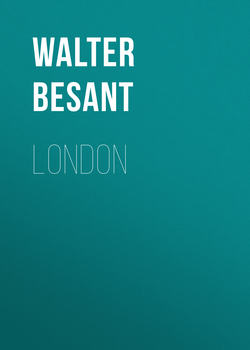Читать книгу London - Walter Besant - Страница 1
ОглавлениеPREFACE
In the following chapters it has been my endeavor to present pictures of the City of London – instantaneous photographs, showing the streets, the buildings, and the citizens at work and at play. Above all, the citizens: with their daily life in the streets, in the shops, in the churches, and in the houses; the merchant in the quays and on 'Change; the shopkeeper of Cheapside; the priests and the monks and the friars; the shouting of those who sell; the laughter and singing of those who feast and drink; the ringing of the bells; the dragging of the criminal to the pillory; the Riding of the Lord Mayor and Aldermen; the river with its boats and barges; the cheerful sound of pipe and tabor; the stage with its tumblers and its rope-dancers; the 'prentices with their clubs; the evening dance in the streets. I want my pictures to show all these things. The history of London has been undertaken by many writers; the presentment of the city and the people from age to age has never yet, I believe, been attempted.
The sources whence one derives the materials for such an attempt are, in the earlier stages, perfectly well known and accessible to all. Chaucer, Froissart, Lydgate, certain volumes of the "Early English Text Society," occur to everybody. But the richest mine, for him who digs after the daily life of the London citizen during the fourteenth and fifteenth centuries, is certainly Riley's great book of Extracts from the City Records. If there is any life or any reality in the three chapters of this book which treat of the Plantagenet period, it is certainly due to Riley.
As regards the Tudor period, the wealth of illustration is astonishing. One might as well be writing of the city life of this day, so copious are the materials. But it is not to Shakespeare and the dramatists that we must look for the details so much as to the minor writers, the moralists and satirists, of whom the ordinary world knows nothing.
The reign of Charles II. directs one to the Plague and to the Fire. I was fortunate in finding two tracts, one dealing with the plague of 1603, and the other with that of 1625. These, though they are earlier than Charles II., were invaluable, as illustrating the effect of the pestilence in causing an exodus of all who could get away, which took place as much in these earlier years as in 1666. Contemporary tracts on the state of London after the Fire, also happily discovered, proved useful. And when the Plague and the Fire had been dismissed, another extraordinary piece of good fortune put me in possession of certain household accounts which enabled me to present a bourgeois family of the period at home.
Where there is so much to speak about, one must exercise care in selection. I have endeavored to avoid as much as possible those points which have already been presented. For instance, the growth of the municipality, the rise of the Guilds and the Companies, the laws of London, the relations of the City to the Sovereign and the State – these things belong to the continuous historian, not to him who draws a picture of a given time. In the latter case it is the effect of law, not its growth, which is important. Thus I have spoken of the pilgrimizing in the time of Henry II.; of the Mysteries of that time; things that belonged to the daily life; rather than to matters of policy, the stubborn tenacity of the City, or the changes that were coming over the conditions of existence and of trade. Again, in Plantagenet London one might have dwelt at length upon the action taken by London in successive civil wars. That, again, belongs to the historian. I have contented myself with sketching the churches and the monasteries, the palaces and the men-at-arms, the merchants and the workmen.
Again, in the time of George II., the increase of trade, which then advanced by leaps and bounds, the widening of the world to London enterprise, the part which London took in the conquest of India and the ejection of France from North America belong to history. For my own part I have preferred to show the position, the influence, and the work of the Church at a time generally believed to be the deadest period in the whole history of the Church of England. This done, I have gone on to illustrate the day-by-day life of the citizens, with the prices of things, the management, and the appearance of the City.
One thing remains to be said. Mr. Loftie, in his History of London (Stadford), first gave the world a reconstruction of the ground – the terrain – of London and its environs before ever a house was erected or an acre cleared. The first chapter of this book – that on Roman London and After – is chiefly due to a study of this map, and to realizing what that map means when applied to the scanty records of Augusta. This map enabled me to recover the years which followed the retreat of the Romans. I cannot allow this chapter to be called a Theory. It is, I venture to claim for it, nothing less than a Recovery.
WALTER BESANT.
United University Club:
